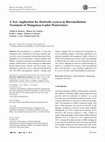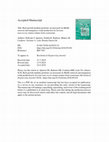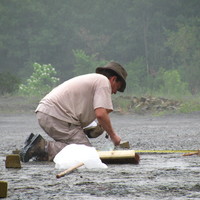Papers by Pollyana Queiroz

Water, Air, & Soil Pollution, 2018
Bioremediation is a method of removing manganese from wastewaters, and many bacterial species wit... more Bioremediation is a method of removing manganese from wastewaters, and many bacterial species with a role in manganese bioremediation have been identified over several decades. Using K medium with Mn(II), a bacterial consortium was obtained from water sample collected from a mine drainage in southeastern Brazil (Minas Gerais, Brazil), and the isolates were identified as Klebsiella oxytoca using both biochemical and 16S rRNA phylogenetic analysis. Among such isolates, sample SA8 was tested for its manganese removal capability during a week-long experiment in K medium amended with manganese sulfate. Growth of isolate SA8 produced an increase in pH concomitantly to Mn(II) removal, which was not observed in the abiotic control. Manganese removal occurred through oxidation as confirmed by reaction with leucoberbelin blue, and therefore, a new potential application for K. oxytoca in mine water bioremediation is proposed.
Biochemical Engineering Journal, 2018
Highlights Serratia marcescens strains exhibited high tolerance to Mn(II) (0-2000 mg L −1) NB... more Highlights Serratia marcescens strains exhibited high tolerance to Mn(II) (0-2000 mg L −1) NB medium greatly influenced the Mn removal and oxide formation EDX analysis revealed Mn outside of the cell for non-pigmented CL11 strain EELS analysis revealed Mn inside the cell for pigmented LG1 strain Both strains showed a good performance, especially the pigmented strain
BMC Biotechnology, 2018
Background: Proteomics is an important tool for the investigation of dynamic physiological respon... more Background: Proteomics is an important tool for the investigation of dynamic physiological responses of microbes under heavy metal stress. To gain insight into how bacteria respond to manganese (II) and identify the proteins involved in Mn (II) oxidation, the shotgun proteomics approach was applied to a potential Mn (II)-oxidizing Serratia marcescens strain cultivated in the absence and presence of Mn (II).

Biochemical Engineering Journal, 2018
This study investigated the performance of two different strains of Serratia marcescens on the ma... more This study investigated the performance of two different strains of Serratia marcescens on the manganese (II) removal and the effects of the nutrient-rich (NB medium) and nutrient-poor culture (K medium) media on this process. In the NB medium, the pigmented LG1 strain and the non-pigmented CL11 strain exhibited improved growth and higher Mn(II) tolerance (0–2000 mg L−1). In addition, improved Mn(II) removal (64.25%) and increased formation of Mn oxides were observed in this medium, especially for the LG1 isolate. EELS analysis revealed Mn inside the cell for LG1 and EDX analysis revealed Mn outside of the cell for CL11, indicating that the two strains remove Mn(II) via distinct mechanisms. The biooxidation of Mn by the CL11 strain may involve indirect mechanisms which alter the pH of the medium, whereas the LG1 strain may use a direct mechanism for the biooxidation mediated by cellular components such as intracellular proteins. These results demonstrate the biotechnological potential of the two strains. In addition, is the first time the high potential of the NB medium for Mn removal is demonstrated. This medium was found to greatly influence the Mn removal and oxide formation, especially in the case of the pigmented LG1 isolate.











Uploads
Papers by Pollyana Queiroz